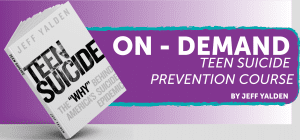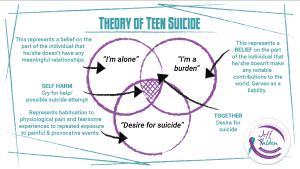"Jeff, I wish you could help us finish out the next four weeks. We need your help. Our kids and staff loved having you for the day.” – Linda Garza, Principal, Woodsboro High School, Texas
Why Do Teens Self-Harm
 It’s important to understand the signs and symptoms of teens in distress and how best to intervene as their trusted adults.
Understand that the consequences of this self-harm behavior goes beyond physical harm. It includes depression, anxiety, stress, overwhelming feels, social isolation – isolation is toxic, and can certainly be an increased risk for a suicide attempt.
Intervening early can save a life or a future of negative coping and problem-solving skills.
Self-harm is a highly prevalent behavior in our middle school, high schools, on college campuses, and in our communities. It really highlights the fact that we really need to address this behavior and start the conversations in our schools. Our teachers, coaches, and school personnel are so important and vital in the conversation around teen mental health, self-harm, and suicide prevention.
Self-Harm is the Primer to Suicide
Researchers have speculated that self-harm might prime teens for suicide as long as they’re able to overcome the fear and pain that comes from self-harm.
It’s important to understand the signs and symptoms of teens in distress and how best to intervene as their trusted adults.
Understand that the consequences of this self-harm behavior goes beyond physical harm. It includes depression, anxiety, stress, overwhelming feels, social isolation – isolation is toxic, and can certainly be an increased risk for a suicide attempt.
Intervening early can save a life or a future of negative coping and problem-solving skills.
Self-harm is a highly prevalent behavior in our middle school, high schools, on college campuses, and in our communities. It really highlights the fact that we really need to address this behavior and start the conversations in our schools. Our teachers, coaches, and school personnel are so important and vital in the conversation around teen mental health, self-harm, and suicide prevention.
Self-Harm is the Primer to Suicide
Researchers have speculated that self-harm might prime teens for suicide as long as they’re able to overcome the fear and pain that comes from self-harm. When Jeff ask teens about self-harm and why they haven’t made the forever decision yet, they say, “It would hurt too much.” Or, “I couldn’t do that to my friends, family.” These are major red flags. Jeff says, if a student is self-harming (cutting) and not getting the help they need then two things start to happen:
When Jeff ask teens about self-harm and why they haven’t made the forever decision yet, they say, “It would hurt too much.” Or, “I couldn’t do that to my friends, family.” These are major red flags. Jeff says, if a student is self-harming (cutting) and not getting the help they need then two things start to happen:
- The individual starts to tolerate the pain
- The individual starts to justify why taking their life is the right thing to do

Self-Harm & Increased Risk of Suicide
There is also some evidence that people who engage in non-suicidal self-injury are at an increased risk of suicide. The evidence mostly links strongest with those patients in
- Feelings of Being Alone – Teens feel they lack meaningful relationships.
- Disappointment – Teens feel they’re a disappointment to family, friends, teachers, coaches. They don’t want to burden you with their problems.

Coping with Emotions
Teens engage in self-injury as a way to cope with their emotions, particularly the negative ones. Most teens that talk about self-injuring themselves say that it works. That self-harm makes them feel better. It calms them down and brings a sense of relief. When Jeff is meeting with a teen who is self-harming themselves, Jeff listens and after gaining their trust and respect he says, “Self-harm is a good thing in that you’re recognizing it isn’t the healthy way of asking or getting help.” The teen is shocked by what Jeff is saying, but Jeff does this because they’re at a defining moment where Jeff knows he is able to get into their heart and get them the help to reframe and come up with better coping skills to deal with their pain and emotions.” Jeff says he likes that the teen is aware self-harming isn’t healthy and they’re coping in the wrong manner. To know this isn’t healthy and to keep knowing that you want to deal with emotions in a more healthy manner is what Jeff wants them to start realizing. With the right help and trusted relationships, the teen will open up and see that asking is okay and that is what they need. We need to talk with our teens in our schools. We need to give them permission to be able to reach out and that reaching out is safe. Jeff wants our teens to realize their teachers, coaches, other staff members, that they are trusted and significant adults that truly care. If you work with teens in any capacity it’s a great responsibility and privilege to help our youth deal with their thoughts and emotions in a more healthy manner. If we don’t teach our youth in their young years, their unhealthy coping skills will manifest and appear later and throughout your life causing greater issues and problems.But Why Self-Harm?
Self-harm is soothing. Self-harm makes the teen feel better in the moment they’re self-harming. Self-harm releases endorphins. Endorphins are brain chemicals that relieve pain and can produce euphoria in a way similar to a runner getting that endorphin effect, running. Teens use self-harm in a ways that other people use drugs or alcohol, food, gambling, or sex . . . to try to feel better in the hear and the now. Young people live in the here and the now and that is a challenge of understanding and getting across to our youth is that life isn’t in the here and the now. Teens might also self-harm as a form of punishment. Here are four main reasons for engaging in self-injury. Teens self-harm to:
- relieve tension or stop bad feelings
- feel something, even if it’s pain; The individual wants control
- communicate with others to show they are distressed
- get others to stop bothering them
It’s Prime Time for Teens to Engage in Self-Harm
From a development perspective, it’s the perfect storm for self-harm as teens are growing through these stages of life. Navigating personal relationships, the brains and bodies maturing and going through major changes. Their hormones, emotions, puberty, self identity, and more . . . This is prime time as they’re living 24/7 and simply are trying to breathe with how fast life is passing by and they’re trying to keep up with it. Part of the brain involved in emotion, the amygdala, and part of the brain involved in higher thinking, the cortex, are not fully connected, and as a result, they don’t communicate as well as they do later in life. The teen brain doesn’t mature until they’re about 24-25 years old. It’s very common for teens, particularly early adolescents, to feel high levels of emotion and really not have many skills to deal with the emotion. Teens are more reactionary and don’t understand that in a matter of time answers will appear and what they’re dealing with in the now will be okay in a couple of days, or even in a couple of hours. That is why Jeff always says, “Take Time To Think.” When the brains are fully developed, they may learn other more positive methods for coping with their emotions, such as talking to a friend, exercise, or ask a professional for help. Self-injury does seem to be a behavior many teens grow out of, with around 80 percent reporting that they stopped injuring themselves within five years of starting. That is good news. However, let’s not ignore the fact that we need to engage in the conversations. From a practical point of view, self-harm is an easily accessible behavior for teens who might have a hard time getting a hold of drugs and alcohol. Let’s get to them before they start self-medicating and engaging in a deeper form of self-harm that they’ll be in denial about.Gender Differences in Self-Harm
Research once suggested that self-harm is a more common behavior among girls. More recent research says there is more of an even split between boys and girls. Jeff says that today he thinks self-harm is higher amongst boys than it is girls. However, keep in mind, girls and boys might use different methods for hurting themselves and some methods are more noticeable than others. Example, girls are more likely to cut while boys are more likely to use more masculine ways such as reckless behavior or burning themselves. Girls look for more feminine ways and boys look for more manly or masculine ways of self-harm.Treating Self-Harm
 Those that self-harm are more than likely to overcome their behaviors without seeking treatment, but treatment early on is the best help they can receive. It’s important to discuss this with the teen and the family and help them find more positive coping skills. This does need to be reported and dealt with in a non-judgmental and safe manner as to not upset the individual. Having a record on hand and reporting the situation will take the burden off you the trusted adult who intervened.
Consider this . . .
Don’t overreact. Don’t get mad. Don’t fix it. Don’t punish the child if you are the parent or guardian.
This is very serious and a moment in the child’s life that you can earn their trust and respect in crisis situations. Let them know unconditionally you care about him or her and are willing to help in any way. Validate their thoughts and feelings, but let them know there are safe ways of handling your emotions and you are there to help without judgement.
Anyone who has engaged in self-harm, even if it’s just one time, has reported more challenges and difficulties in their life. Psychologically and socially. So, if you know a student or a teenager and they’re self-harming, it is imperative to talk with the individual and get them the right help.
Those that self-harm are more than likely to overcome their behaviors without seeking treatment, but treatment early on is the best help they can receive. It’s important to discuss this with the teen and the family and help them find more positive coping skills. This does need to be reported and dealt with in a non-judgmental and safe manner as to not upset the individual. Having a record on hand and reporting the situation will take the burden off you the trusted adult who intervened.
Consider this . . .
Don’t overreact. Don’t get mad. Don’t fix it. Don’t punish the child if you are the parent or guardian.
This is very serious and a moment in the child’s life that you can earn their trust and respect in crisis situations. Let them know unconditionally you care about him or her and are willing to help in any way. Validate their thoughts and feelings, but let them know there are safe ways of handling your emotions and you are there to help without judgement.
Anyone who has engaged in self-harm, even if it’s just one time, has reported more challenges and difficulties in their life. Psychologically and socially. So, if you know a student or a teenager and they’re self-harming, it is imperative to talk with the individual and get them the right help. 
